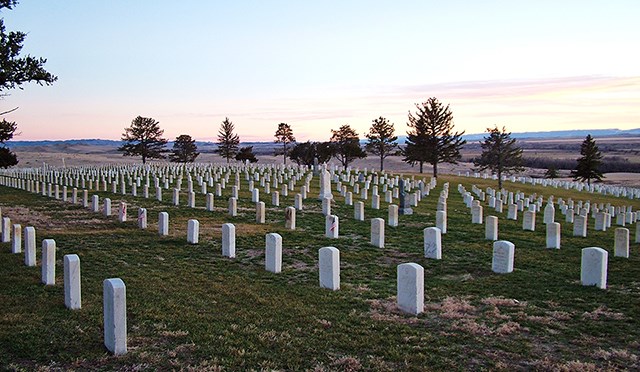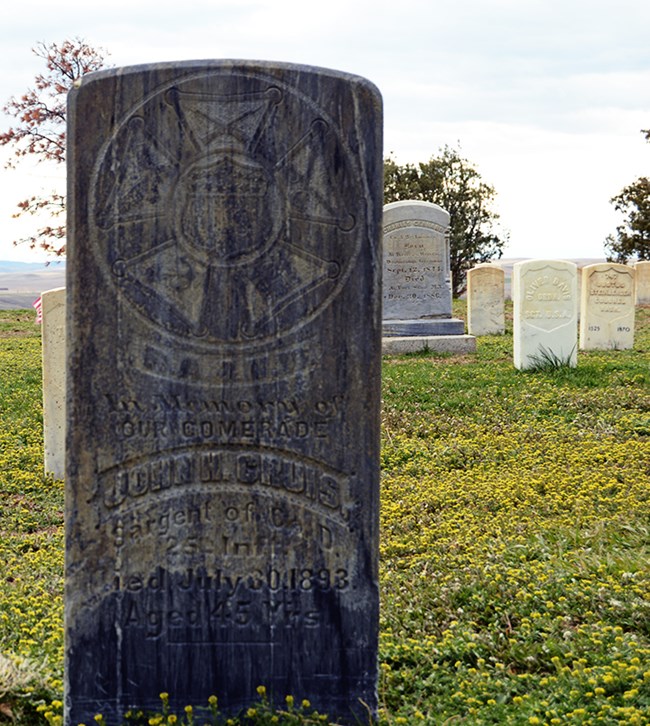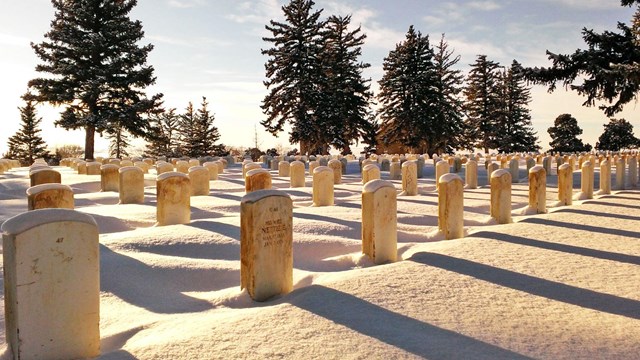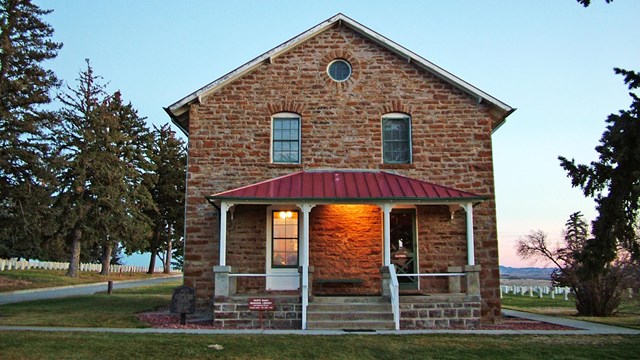

Left image
Right image

NPS photo Your visit to the Custer National Cemetery at Little Bighorn Battlefield is like a trip through time. You will relive the drama of America's coming of age as you walk along the graves of known and unknown veterans of our nation's wars, including women and children from isolated frontier posts, Indian scouts, and Medal of Honor recipients.

NPS Photo S.Smith History of National CemeteriesPrior to the establishment of national cemeteries, one of two things would happen to soldiers and other military personnel who died during service: they were either buried where they died, such as the battlefield or military post cemeteries of the West or they were taken to private cemeteries. Generally, the family was in charge of all arrangements. The Civil War changed all of this. It produced an unprecedented number of corpses that neither side was equipped to handle. The agonizing uncertainty of the families left behind as to whether their loved one was alive or dead led to public demand that the government take responsibility for identification and burial of the dead. As early as September 11, 1861, with the issuance of General Orders No. 75, the Quartermaster General was charged with burial and registry of casualties. By 1862, fourteen national cemeteries had been established, mostly on Eastern battlefields. Congress passed the first National Cemetery Act in 1867. It provided funds to purchase land, outlined common features, and defined appropriate, acceptable behaviors within the cemetery walls. In National Cemeteries, all rest as equals. This is opposite to the rigid caste system that defined day-to-day military operations. Here in the Custer National Cemetery, for example, Brevet Brigadier General Marcus Reno is buried directly beside Private Dale Hepler, conferring to each soldier an equal honor in death regardless of their military rank or socioeconomic status in life. National Cemetery DesignationLike many other national cemeteries, Custer National Cemetery was created after those killed in battle were already buried here. Between 1877 and 1881, troops garrisoned at nearby Fort Custer (modern-day town of Hardin, Montana) regularly gathered remains for reburial, recovered graves, and policed the battlefield for exposed bones. The first of these details disinterred and collected all identified officers, except Lieutenant John Crittenden. Lt. Crittenden was left where he fell at the request of his family until 1932. General Custer was reinterred at West Point while most of the others were shipped to Fort Leavenworth, Kansas and other private cemeteries back east at the request of their families. In order to protect these graves, General William Tecumseh Sherman issued General Order No. 78 in 1879. This order designated part of the Custer Battlefield as a national cemetery. By 1881, a memorial was erected in honor of the Seventh U.S. Cavalrymen who perished on the battlefield. Prior to installment of the monument, a trench was dug around the base into which all of the bodies that could be found to that date were placed. Though an attempt was made to rebury all of these individuals, bones discovered since have been buried in the National Cemetery as "Unknowns." In 1886, President Grover Cleveland reconfirmed Sherman's 1879 order with War Department General Orders of December 7, 1886. This established a one square mile area for the "National Cemetery of Custer's Battle-field Reservation." Within a decade, the Quartermaster General surveyed the site to locate an ideal tract for an enclosed cemetery. Civil engineer W.H. Owen surveyed the area and recommended a 6.91 acre plot. This would encompass all present interments as well as leave room for a superintendent's lodge. Furthermore, this plan would require only 111 reinterments. After consideration of reburials, environmental conditions (including topography, soil, and elevation), gravestone alignment, and relationship to the monument, access to water was the decisive factor in selecting an appropriate site. Furthermore, as Owen reported in 1893, this location would leave the battlefield intact "as a matter of sentiment and historical fitness." To preserve its historic character, President Franklin Delano Roosevelt issued Executive Order 8428 to transfer the custody, care, and management of the cemetery from the War Department to the Department of the Interior effective July 1, 1940. Six years later, Congress approved the redesignation Custer National Cemetery as Custer National Battlefield. Another name change occurred in 1991 to Little Bighorn Battlefield National Monument "to better honor all the men who perished in the Battle of the Little Bighorn," separately naming Custer National Cemetery. Today, the National Park Service administers just fourteen of the more than 150 cemeteries in the National Cemetery System. In January of 1978 Custer National Cemetery closed for reservations. This means that no new reservations will be accepted, but the burials of those with prior arrangements will continue.

NPS photo Use the National Cemetary Adminstration's Nationwide Gravsite Locator to locate interments at Custer National Cemetery. 
Markers and Memorials
Historic photographs of the Little Bighorn Battlefield memorials and Custer National Cemetery markers. 
Library
Have questions for our librarian? Want to make a research request? |
Last updated: April 23, 2025
